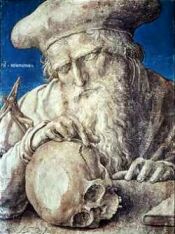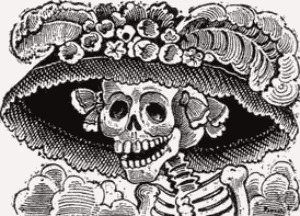Skull (symbolism)
|
|
Skull symbolism is instinctive in human nature. We recognize the fragments of a cranium in the earth, even when other bones look like shards of stone. The human mind is primed to recognize faces, and so eager to find them that it can see faces in a few dots and lines or punctuation marks; the face that looks back from a human skull cannot avoid recognition as having been once human. Moreover, a human skull, with its eyes much larger than in life, displays a degree of neoteny, which humans often find visually appealing. Yet, a skull is obviously dead. As such, human skulls have a visual appeal beyond the other bones of the human skeleton, and can fascinate even as they repel.
The Neanderthals painted the skulls of their respectfully buried dead with red ochre coloring: a transfusion to carry its late inhabitant into the Next World: where there is metaphor there is humanity.
The skull that is engraved or carved in the head of early New England tombstones might be merely a symbol of mortality, but often the skull is backed by an angelic pair of wings, lofting mortality beyond its own death.
Shakespeare's Hamlet, the prince of Denmark, recognizes his old tutor: "Alas, poor Yorick! I knew him, Horatio; a fellow of infinite jest. . ." and is inspired to his bitter soliloquy of despair and rough ironic humor. (Compare Hamlet's words "Here hung those lips that I have kissed I know not how oft." to Talmudic sources: "…Rabi Ishmael [the High Priest]… put [the decapitated head of a martyr] in his lap… and cried: oh sacred mouth!…who buried you in ashes…!"). The Skull was an emblem of Melancholy for Shakespeare's contemporaries.
The skull has no flesh or tongue yet it speaks. Do not rashly assume that the emblem of a skull is a mere symbol of Death. What does the skull say, when we see it so significantly placed on the writing desk of Saint Jerome in Albrecht Dürer's woodcut? (illustration, right) Not truly Memento mori. The skull's huge emptied eye-sockets contrast with Jerome's closed eyes, in one of the best evocations of the interior vision of contemplation, focused on Eternity perhaps, ever realized in Western art.
Venetian painters of the 16th century elaborated moral allegories for their patrons, and memento mori was a common theme. The theme carried by an inscription on a rustic tomb, "Et in Arcadia ego"—"I too [am] in Arcadia," if it is Death that is speaking—is made famous by two paintings by Nicholas Poussin, but the motto made its pictorial debut in Guercino's version, 1618 - 22 (in the Galleria Barberini, Rome): in it, two awestruck young shepherds come upon an inscribed plinth, in which the inscription ET IN ARCADIA EGO gains force from the prominent presence of a wormy skull in the foreground.
Next to the Magdalene's dressing-mirror, in a convention of Baroque painting, the Skull has quite different connotations and reminds the viewer that the Magdalene has become a symbol for repentance. Who has not seen C. Allan Gilbert's much-reproduced lithograph (illustrated below left) of a lovely Gibson Girl seated at her fashionable toilette, and witnessed its transformation into its alternate image? A ghostly echo of the worldly Magdalene's repentance motif lurks behind this turn-of-the 20th century icon.
Allisvanity.jpg
The Skull becomes an icon itself when its painted representation becomes a substitute for the real thing. Simon Schama chronicled the ambivalence of the Dutch to their own worldly success during the Dutch Golden Age of the first half of the 17th century in The Embarrassment of Riches. The possibly frivolous and merely decorative nature of the still life genre was avoided by Pieter Claesz in his "Vanitas" (illustration, below right): Skull, opened case-watch, overturned emptied wineglasss, snuffed candle, book: "Lo, the wine of life runs out, the spirit is snuffed, oh Man, for all your learning, time yet runs on: Vanity!" The visual cues of the hurry and violence of life are contrasted with eternity in this somber, still and utterly silent painting.
Claesz-vanitas.jpg
How can it be that when it is represented in Nazi SS insignia the death's-head (Totenkopf) deals the fear of death, but when tattooed on the forearm its apotropaic power helps an outlaw biker cheat death? The Skull and crossbones signify Poison when they appears on a glass bottle containing a white powder. But it is not the same emblem when it flies above the poop as the Jolly Roger: there the pirates' death's-head epitomizes the pirate despair, their challenge to the natural order and to inevitable Death itself.
When a skull is worn as a trophy on the belt of the Lombard king Alaric, it is a constant grim triumph over his old enemy, and he drinks from it. Thus a skull is a warning when it decorates the palisade of a city, or deteriorates on a pike at a Traitor's Gate. The Skull Tower, with the embedded skulls of Serbian rebels, was built in 1809 on the highway near Nis, Serbia, as a stark political warning from the Ottoman government: the skulls are the statement.
A skull adorns the altar of a pagan Gaulish tribe, and the rafters of a traditional Jivaro medicine house in Peru, or across the world in New Guinea. The temple of Kali is veneered with skulls, but the goddess Kali offers life through the welter of blood. The late medieval Netherlandish painters place the skull where it lies at the foot of the Cross at Golgotha, "the place of the skull." But for them it has become quite specifically the skull of Adam.
The symbolic image of the skull permeates the Indiana Jones movies to such an extent that skulls become décor—and even comic relief when Marion encounters multiple cobwebby skulls and skeletons during the escape from the subterranean Map Room at Tanis (Raiders of the Lost Ark 1981). Every appearance of a skull in the Jones series emphasizes the 1930s' cultural view: a gulf between the rational, modern, progressive, scientific, and vigorously physical daylight world embodied by the intrepid American archaeologist, with the sinister, dangerous, mythical, exotic, dead lore of Antiqity or the Orient in torchlit interiors of caves and temples, as well as exemplifying the fate of those who have gone before but failed.
What does it signify when the Serpent crawls through the eyes of a skull, a familiar image that survives in contemporary Goth subculture? The serpent is a chthonic god of knowledge, and of immortality, because he sloughs off his skin. The serpent guards the Tree in the Greek Garden of the Hesperides and, not that much earlier, a Tree in the Garden of Eden. The Serpent in the Skull always is making his way through the socket that was the eye: knowledge persists beyond death, the emblem says, and the Serpent has the secret.
The skull speaks. It says "Et in Arcadia ego." or simply "Vanitas." Who has not seen a skull crowned by a chaplet of dried roses? "Carpe diem" though rarely so bedecked as Mexican printmaker José Guadalupe Posada's Catrina (illustration). The Skull speaks in the catacombs of the Capuchin brothers beneath the church of S.Maria della Concezione in Rome, where disassembled bones and teeth and skulls of the departed Capuchins have been rearranged to form a rich Baroque architecture of the human condition, in a series of anterooms and subterranean chapels with the inscription, set in bones:
- noi eravamo quello che voi siete, e quello che noi siamo voi sarete.
- ("We were what you are; and what we are, you will be.")
An old Yoruba folktale tells of a man who encountered a skull mounted on a post by the wayside. To his astonishment, the skull spoke. The man asked the skull why it was mounted there. The skull said that it was mounted there for talking. The man then went to the king, and told the king of the marvel he had found, a talking skull. The king and the man returned to the place where the skull was mounted; the skull remained silent. The king then commanded that the man be beheaded, and ordered that his head be mounted in place of the skull.
The giant gorilla King Kong had his home on "Skull Island," presumably a place of dangerous power. Perhaps a similar power flows to the superhero He-Man from Castle Grayskull, a castle shaped like a huge gray skull. It has been suggested that the relationship of He-Man and the sorceress of Grayskull mirrors Carl Jung's ideas about the animus and the anima: the sorceress, an all-knowing woman, is the source of the hero's power, and she dwells within the head. Still, the skullface of Grayskull is also the face of Skeletor, He-Man's enemy.
External link
- Eamining the symbolism of the anamorphic skull in Hans Holbein's double portrait The Ambassadors (http://employees.oneonta.edu/farberas/arth/ARTH214/Ambassadors_Home.html#anchor1386598)
- "Skulls and the Motorcycle" (http://motorcyclecity.com/skulls/)


